Photos: Journey into the Tropical Andes

The Páramo

The Páramo comprises a number of neotropical high altitude grassland ecosystems found from Costa Rica to Bolivia. Páramo ecosystems exist only in high elevations (typically over about 16,400 feet, or 5,000 meters), primarily in the upper parts of the Northern Andes Mountains. Colombia alone contains 57 percent of all the páramo by area in the world, with one of the largest areas at Sumapaz, not far from the capital city of Bogotá.
Páramo vegetation consists of tussock grasses, dwarf shrubs, cushion plants and other forms of vegetation adapted to the cold, wind and intense ultra-violet radiation found at high altitudes. The lower limits of these grasslands are typically bounded by montane cloud forest, which in the absence of human burning, slowly encroaches on páramo vegetation altering the grasslands into forest with time.
Out of the Pleistocene
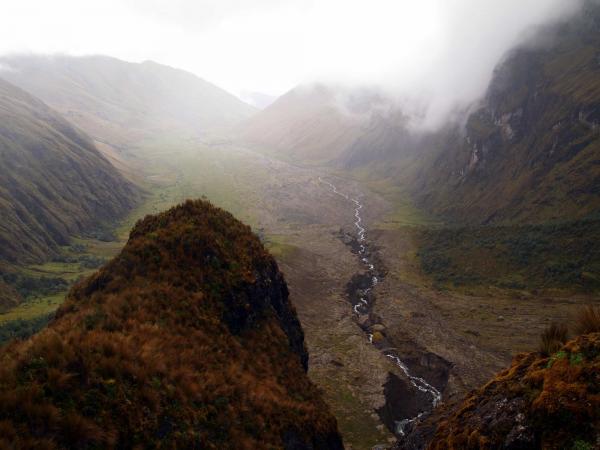
The origins of páramo go back to the ice ages when massive ice sheets covered the high Andes and glaciers snaked over the landscape. These glacial forces formed deep valleys, broad plains and hollowed out lakes over the Andean landscape we see today. In some places, such as El Altar, an extinct volcano on the edge of Sangay National Park in Ecuador, it is easy to feel like you are walking through the Pleistocene (which lasted from about 2.5 million to 12,000 years ago), glimpsing into the last ice age, about 14,000 to 36,000 years ago.
Here broad flat plains wind through steep and rocky canyons clearly carved by ancient glaciers. Walking in these valleys, you may notice huge boulders left behind by the retreat of the ice and sinuous rivers cascading down from mountaintops covered in mist. If you look closer, you may notice life all around you too.
Páramo ecosystems hold more than 5,000 different plant species, in addition to a variety of mostly endemic mammals, birds and amphibians found almost nowhere else.
Andean Condor

If you are exceedingly lucky when you trek through the páramo, you may notice the giant shadow of an Andean condor (Vultur gryphus) passing overhead.
In Andean cosmology the condor was associated with the sun deity and was believed to rule the upper world. Symbols of health and prosperity, the condor continues to represent a powerful omen. With a wing span of up to 10.5 feet (3.2 m), Andean condors have the largest wingspan of any land bird in the world. Feeding almost exclusively on large carrion, condors are an increasingly rare sight due to lack of large mammal prey, persecution and loss of habitat.
Classified as near threatened by the International Union for Conservation of Nature (IUCN), condors and other rare megafauna species like Andean bears and mountain tapirs continue to survive in the páramo much like their ancestors during the Pleistocene.
Chuquiraga
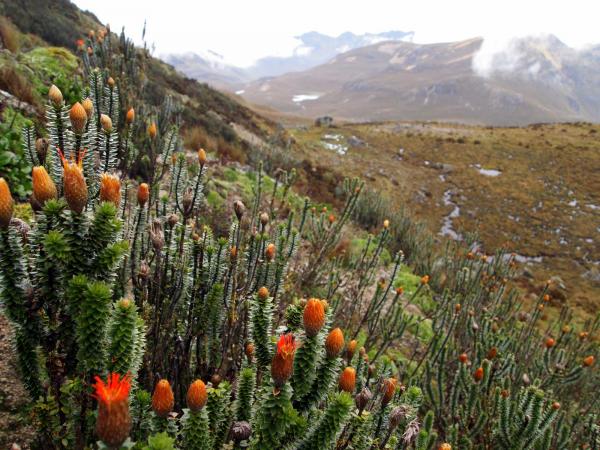
In contrast to the enormous wingspan of the condor, many of the planet's smallest birds also call the páramo home, including the Ecuadorian Hill star (Oreotrochilus chimborazo).
At elevations over 16,000 feet (5,000 meters), they are one of the highest occurring hummingbirds in the world. Bright orange Chuquiraga flowers (Chuquiraga jussieui) like these pictured in Las Cajas National Park in Ecuador are one of the Hill star's favorite food sources.
It may come as a surprise to come across flowers blooming at such high altitudes, but many wildflower species thrive in the páramo. Nestled on the equator many plants have developed unique physiological adaptations to survive the dramatic temperature fluctuations and intense sunlight found at high altitude while benefiting from the near constant growing season of the tropics .
Cushion plant
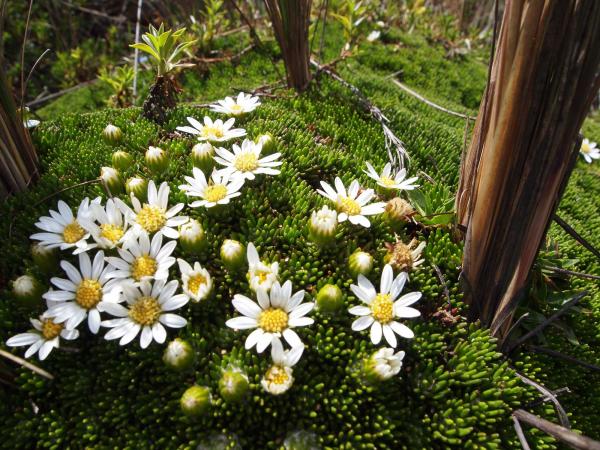
Some plants like this cushion plant in flower have evolved ingenious ways to conserve energy in the harsh conditions of the páramo. Cushion plants, as their name suggests, form low growing cushion-like mounds as a heat saving adaptation to the cold.
Although they may look like one large plant mass, cushion plants are in fact a number of individuals growing closely together almost like a colony. Only the outside exposure of the cushion photosynthesizes sunlight, while inside dead leafy material serves to insulate and trap heat through the natural process of decomposition.
Since cushion plants are able to create greater moisture and heat relative to the surrounding soil, they indirectly help other plants and animals colonize in or on the area they grow. Thus cushion plants could be thought of as ecosystem engineers in the way they are able to enhance the páramo environment for other species.
Puya
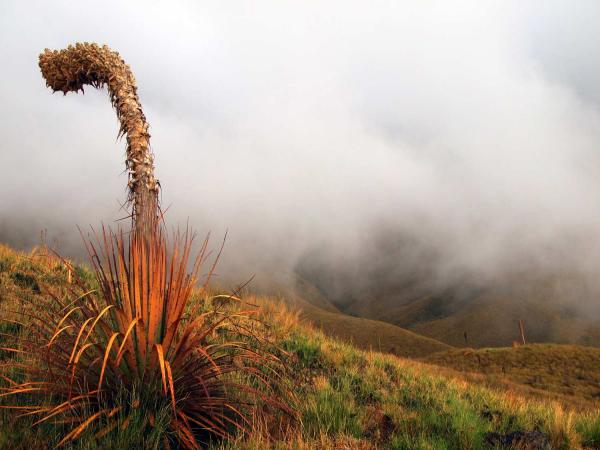
One of the most conspicuous plants of the páramo is the giant puya (Puya clavia-herculis). Giant puya are in the Bromeliaceae family, a family usually found growing in the trees. In contrast, giant puya long ago made the evolutionary leap down to the ground and have benefitted immensely from it.
The unmistakably bizarre shapes of their flowering stalks jutting over the landscape can seem reminiscent of a Dr. Seuss book.
Puyas are long-lived and slow-growing with some species reaching immense sizes. Over the course of their lives, puyas store up energy to one day produce a massive flowering stalk like this one. Once the puya has completed this last act of reproduction, it dies. This all-or-nothing reproduction strategy produces billions of seeds, insuring the next generation of puyas are scattered on the winds.
Pristimantis riveti
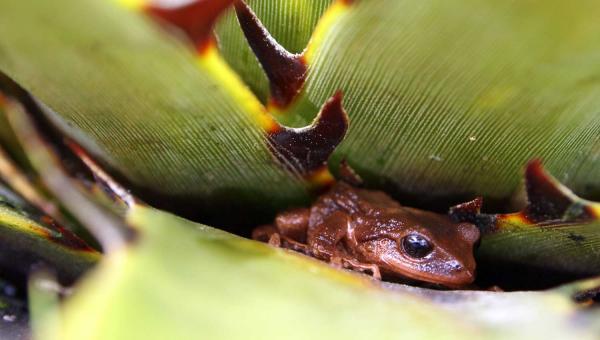
Puya plants' hard waxy leaves make them robust to water loss and fire, an integral part of paramo ecology. Thorns on their leaves also deter many herbivores that might otherwise feed on their leaves, while providing an important refuge for smaller creatures like this endemic robber frog (Pristimantis riveti).
The isolation and fragmentation of páramos throughout the Andean highlands have created the ideal conditions for high levels of endemic species like the robber frog, which is found nowhere else. The high numbers of species and endemism of species here have prompted páramos of the eastern Andes to be included as global biodiversity hotspots .
Get the world’s most fascinating discoveries delivered straight to your inbox.
Páramo burn
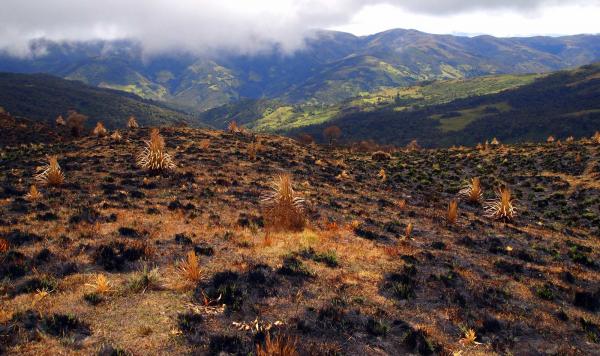
A feeling of wildness, isolation, and remoteness often accompanies a hike through the páramo, but humans have been a part of this landscape for centuries. Archaeological evidence from hunter gathers and pre-Colombian peoples illustrate that large population densities once flourished on these high-altitude pastures.
Today people continue to utilize these grasslands for grazing, logging and periodic burning.
It is still widely debated whether páramo as an ecosystem is able to persist without burning but clearly fire plays an important role in páramo ecology. In many places, without periodic burning by people, forest will slowly displace the grassland through the natural process of succession. Thus it could be argued that páramo is an ecosystem created by people through the use of fire. This páramo pictured in Sangay National Park in Ecuador was burned only weeks before the image was shot.
Alpaca
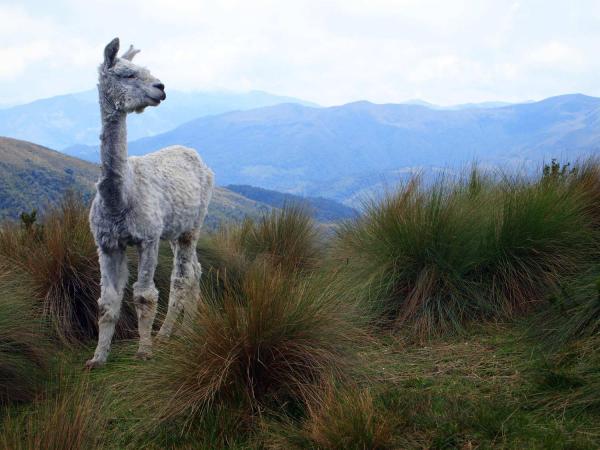
In many parts of the Andes, people have used páramos for centuries as high grazing pastures for their animals. Wild camelid species like alpacas, llamas and vicunas evolved in place with the Andean landscape and were later domesticated by humans, who still graze livestock across this landscape today.
Following the Spanish conquest, llamas and alpacas disappeared from many parts of the Andes to be replaced by European livestock animals. Cattle and sheep have replaced llamas and alpacas traditionally grazed by local peoples in many páramo landscapes since this period.
Increasingly people are reintroducing wild and domesticated camelids back to the páramo today and it is not unusual to see alpacas like this one dotting the hillsides.
Water and carbon storage

Due to the high rainfall they receive and the sponge-like nature of their soils, páramos function as important reservoirs of water. Surface waters originating in páramos provide a consistent base flow of water to many major rivers and therefore play a huge environmental and economic role in water consumption, irrigation and hydroelectric power for many people and governments.
The peat-like, oxygen-poor content of páramo soils can also serve an increasingly important role in organic carbon storage. The páramo's carbon storing abilities offer the potential of offsetting carbon emissions contributing to climate change.
These environmental services and the great diversity of plants and animals that call the páramo home help highlight the many reasons for its conservation.


